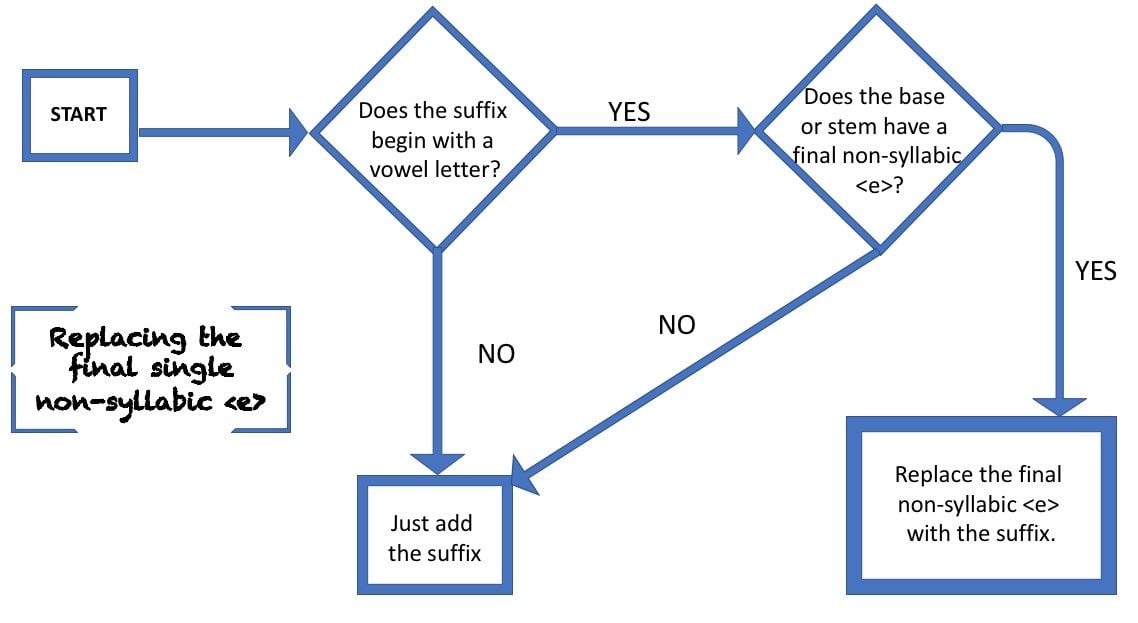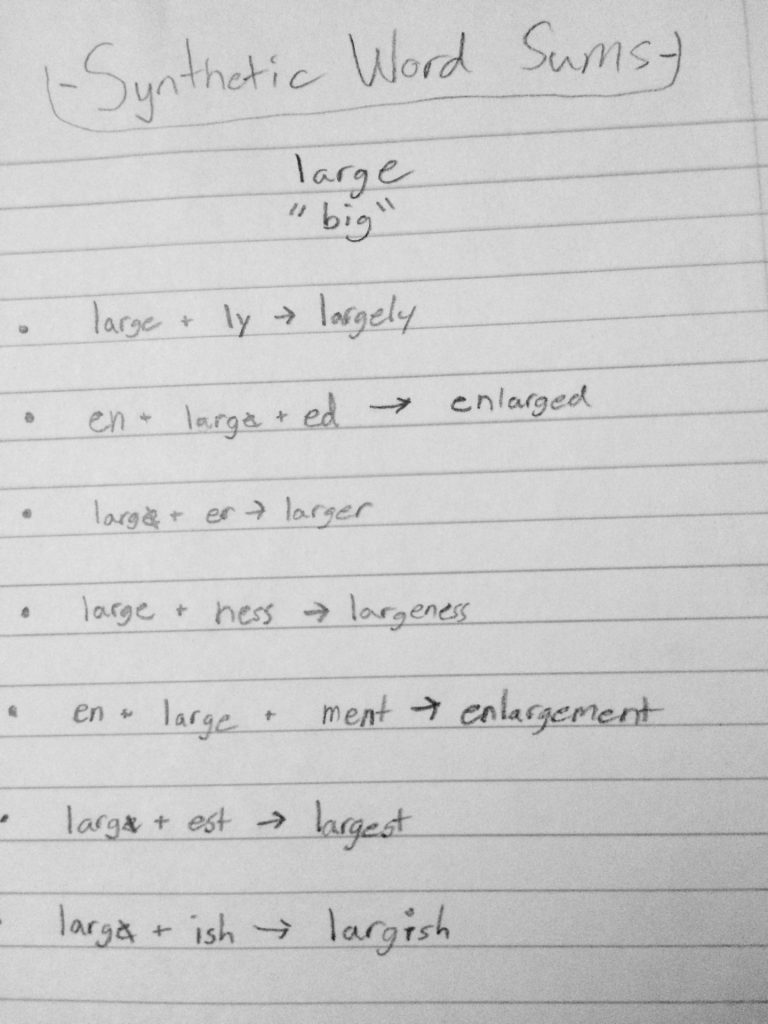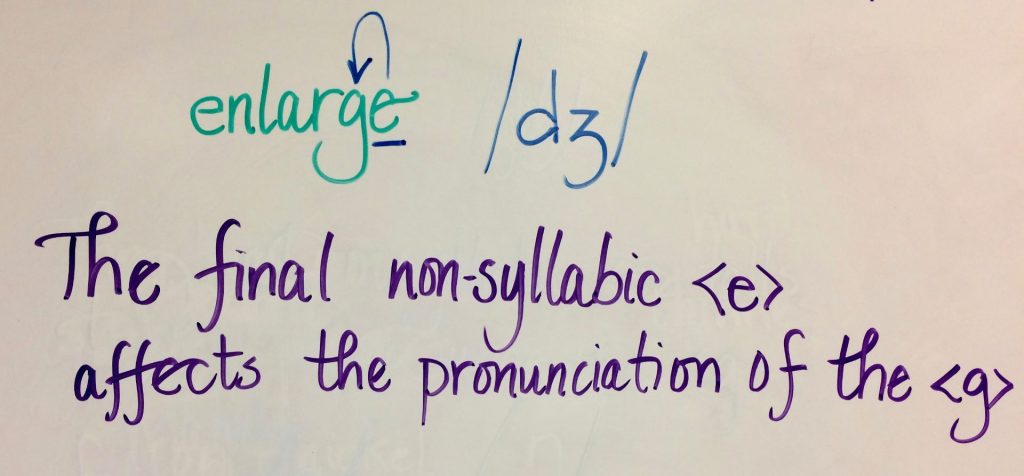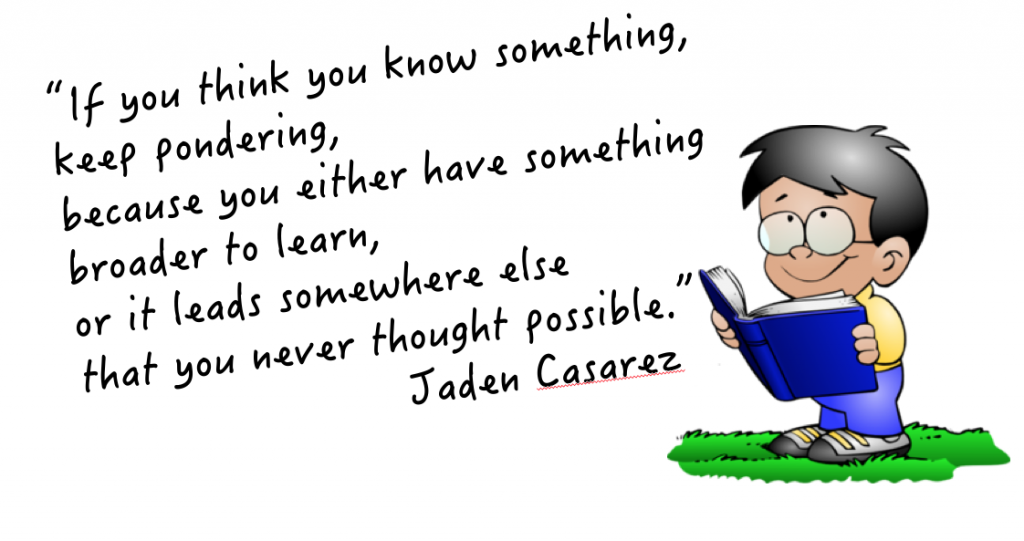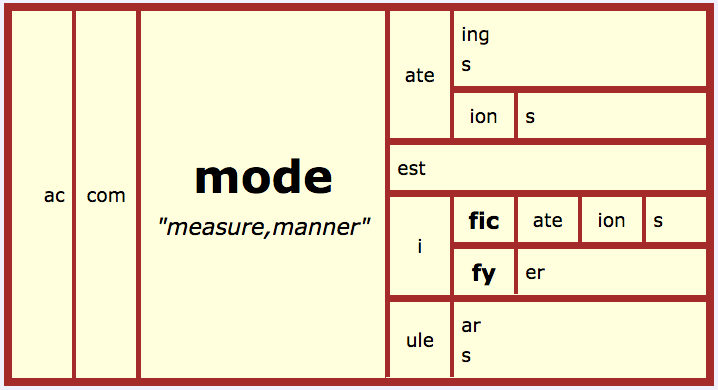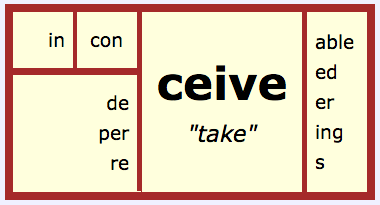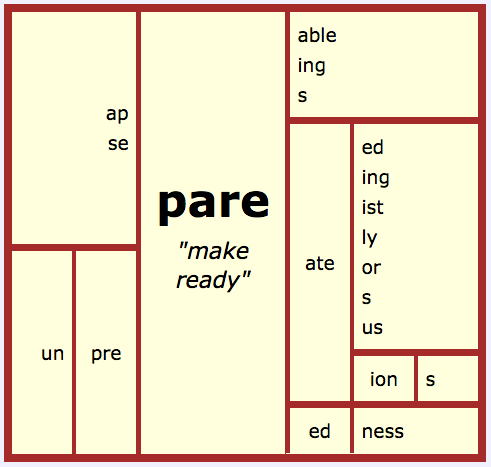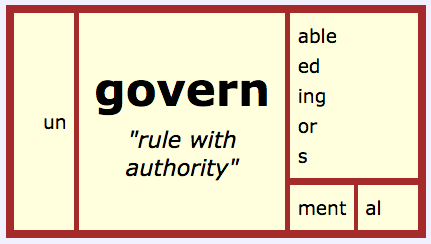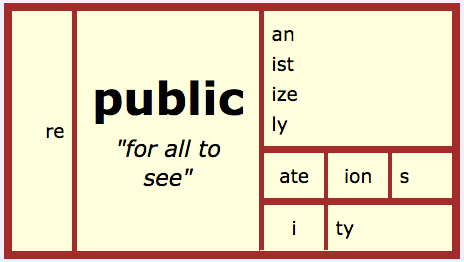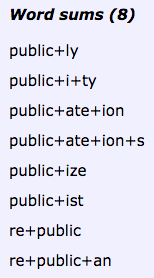Why is it that in a traditional spelling program, students are not taught that a word’s spelling represents its meaning, or that all words have a structure? In most every program, they are taught only, and might I add falsely, that a word’s spelling correlates to its pronunciation. And because the reality of that doesn’t pan out, students learn to spell words as a rote activity. Students spend lots of time looking at words that share similar strings of letters. Ultimately, the expectation is that the student will have seen the word so many times that they will have memorized its spelling. In this model, the students know strings of letters. They do not understand whether those letters form an affix, a base, a combination of more than one of those, or have a sense and meaning on their own. See? The way we teach spelling is not about understanding. The expectation by the teacher and by the student (and by the administration for that matter) is that there is nothing to understand. English spelling is something you just have to memorize.
What a shame. Math would never be taught like this. Who in their right mind would have students memorize one 2-digit by 3-digit multiplication problem at a time with a goal of twenty a week? No one. Instead, we teach the students how to multiply and then expect them to apply the skill to any numbers and situation out there. We expect students to understand the operations and ask questions. We want them to provide step by step explanations for solving problems. But not so with spelling.
The people teaching it right now, are doing the very best job they can. I believe that. They are teaching what they understand to be the truth about English spelling. Ah. But there’s the rub. Their own understanding of our language is lacking. Hugely and completely lacking. At some point in our history (several generations back), it was decided that English was much too hard to learn, and so needed to be simplified. Latin would no longer be taught in schools. If you are fortunate enough to know someone who learned Latin in their early schooling, my guess is that they will tell you how very valuable it still is for them in deciphering what words mean. The very fact that at one point Latin was part of a school curriculum tells you that there was once an awareness that spelling represented a word’s meaning. But when Latin left the curriculum, so did the idea that spelling and meaning were related. It was decided instead that very young children must learn letters and sounds outside of the context of a word, and then apply that knowledge of, say,”S is for snake – s-s-s-s-” when being told to sound out words. But <s> isn’t always representing /s/. Sometimes it represents /z/ as it does in dogs. Sometimes it represents /ʃ/ as it does in sugar. Sometimes it represent /ʒ/ as it does in usual. And <s> isn’t the only consonant like that. Yet we start by teaching young children that it only represents /s/.
I’m not suggesting that children don’t need to know the alphabet. They do. Absolutely, they do. But what if we taught them to look at letters as we see them in words? What if we taught children about graphemes and phonemes as they live and breathe inside of words? What if we picked a word the student uses – better yet, what if we let the child pick the word they are interested in, and we looked at it together. The adult guides by speaking about spelling features, structure, and a word’s story in straight forward terms. The adult does not talk down to the child or invent silly rules or names for things. The adult explains and lets the child ask questions that will help them make sense of English spelling.
One great way to introduce structure to a child is to have them look at a family of words that share a single base. Believe me, structure won’t be the only thing that gets talked about, but it is the big topic starting point. Teaching specific base elements will familiarize children with how we can add and remove affixes to build a family of words. It will also familiarize them with the fact that many of the words in our language are related to one another by their history and their meaning. It opens them up to exploring that not only are we merely forming additional words that share the base, but that some specific suffixes will build word relatives that are nouns whereas others might form adjectives. Students will learn the suffixing conventions in a more meaningful way – with a more intrinsic understanding than they do currently. As is, they come into fifth grade knowing how to spell a bunch of words, but not understanding the structure of any of them. They know that some have similar spellings toward the end of the word or at the beginning, but they have no understanding of why or if it means anything as far as how we use the words in our writing or reading.
When children are starting out learning about a word’s structure, it’s important to help them recognize the affixes they see often in their reading. Even if their reading is not fluent yet, they can compare the words on a list and recognize that letters have been added to the base. They will most certainly recognize these words once read aloud and be able to talk about them. Let’s look at <water>. I found it on a first grade sight word list.
The first question should be, “What is water?” Let the child explain what they understand about water. Looking at the word by itself, use what you know about IPA to guide their pronunciation and match it to the graphemes representing it. Here is the IPA for water: /ˈwɔtɚ /. Please take into consideration any dialects present where you and the child live. That might make a difference to the pronunciation. If we make a list of words with <water> as a base, it might look like this:
water
watered
watering
waterfall
bathwater
rainwater
dishwater
watercolors
watermelon
underwater
Perhaps these could be written on cards (separate cards for each base and suffix) that the child can match up and spell out. As each base is matched with either another base and/or suffix, have a discussion with the child about how that word might be used. The words might also be written in color as I have done to point out bases and affixes. You might begin to introduce to the child the idea that when added to this word, some suffixes will indicate the word is an action. An example of this is ‘watered’. I watered my flowers today. See how watered is an action? But water by itself is a thing. I might drink a glass of water. Draw pictures next to the words to represent either a thing (noun) or an action (verb).
There are some truly great descriptions of activities to do with younger learners at Beyond the Word, Lyn Anderson’s blog, and also at Rebecca Loveless’ blog. I encourage you to check both of them out to read some step by step directives as well as to see how students react.
Another thing to notice about these words in particular is that the parts of the words that are in green are bases. When two bases are joined, they form a compound word. How is rainwater different from bathwater or dishwater? Why are some paints called watercolors? What do you know about watermelon that makes you think of water? What is something that lives underwater?
Before my own children knew how to read, they loved making books. They would tell me a story and I would write it down. Then we would fold paper and they would sew the pages together with a large dull needle. I would write a sentence or two of their story on each page, and they would add the pictures. Every day we would read one of their books together. Bookmaking could be a fun activity using a particular family of words such as water.
If I could design spelling tests, this is certainly how I would do it. After a week of discussing the meanings and uses of these related words, asking the students to spell them seems reasonable. If each week there were words related in this manner, over time students would recognize many prefixes, suffixes, and bases. They would begin to internalize that often words are related to one another; not because they rhyme, but because they have meaning and spelling in common.
Students are ready to understand the suffixing conventions much earlier than most educators think they are. When focusing on one of those conventions, the spelling list could include a base that is likely to use one. Here is a list with <make> as its base. Looking at the word by itself, use what you know about IPA to guide their pronunciation and match it to the graphemes representing it. Here is the IPA for <make>: /meɪk/. Please take into consideration any dialects present where you and the children live. That might make a difference to the pronunciation. Here is a possible spelling list:
make
maker
making
makeup
shoemaker
noisemaker
peacemaking
toymaker
remake
makeover
Here are some points that come to mind:
~What does it mean when we make something?
~How do we construct ‘maker’? Is there an <-r> suffix or an <-er> suffix?
~What kind of a sense does the <-er> suffix add to the word <shoemaker>?
~How many of these words are compound words?
~What is a peacemaker?
~Do you notice how the <c> in <peacemaker> has an /s/ pronunciation? Why is that?
~Why don’t we replace the final non-syllabic <e> when constructing the word <makeup>?
~What is the suffixing convention in which we replace the final non-syllabic <e>?
~Many teachers have learned that the final <e> is dropped. That is also what they teach their students. Why is ‘replaced’ a better word to use?
~Write these as word sums and announce each one.
Equally as important as discussing these concepts as a class, is the ability for each student to read aloud a word sum, explaining as they go, why they are or aren’t replacing the final non-syllabic <e> on the base! Until your student can explain this, keep the following flow chart handy:
If you want to focus on the suffixing convention in which the final consonant of the base is sometimes doubled, perhaps you could use this list. Looking at the word by itself, use what you know about IPA to guide their pronunciation and match it to the graphemes representing it. Here is the IPA for <stop>: /stɑp/. Please take into consideration any dialects present where you and the children live. That might make a difference to the pronunciation. If we make a list of words with stop as a base, it might look like this. As you read it, can you spot some great things to focus on during a week of working with these words?
stop
stops
stopped
stopping
stoplight
stopwatch
stopper
nonstop
stoppable
unstoppable
Here’s what I see when I look at these words:
~What does it mean when something stops?
~Which words on this list are compound words?
~Use ‘stoppable’ and ‘unstoppable’ in sentences. What is the difference in meaning? Which morpheme in those words is responsible for that difference in meaning?
~What is a stopwatch? How does it relate in meaning to stop?
~Look at the <igh> trigraph in <stoplight> that is representing the phoneme /aɪ/. What other words can we think of that have the same <igh> trigraph?
~Now notice the <tch> trigraph in <stopwatch>. I wonder about that <tch>. I can think of beach, pinch, coach, and bench. The last grapheme in these words is <ch> and it represents the phoneme /tʃ/. Let’s start collecting two lists of words. One list will have words with a final <tch>. One list will have words with a final <ch>. Then we will see what we can notice about the two lists. There must be a reason that we use <tch> in the word ‘stopwatch’ and not <ch>.
~What is that spelling convention in which we sometimes double the final consonant of the base or stem? When do we double it? When don’t we?
~Write these as word sums and announce each one.
Just in the nick of time, here is the Affix Squad, ready to explain the doubling convention!
Equally as important as discussing these concepts as a class, is the ability for each student to read aloud a word sum, explaining as they go why they are or aren’t doubling the final consonant on the base! Until your student can explain this, keep the following flow chart handy:
The word ‘business’ has always been a sticky word for fifth graders to spell. But that is because they haven’t been taught to see it as anything but a complete word. They haven’t been taught to see it as < b-u-s – toggle the y to i – ness>. From the time our students are little, we teach them that spelling is about memorizing a letter sequence without understanding the order or structure in that sequence. Or we do them a bigger disservice and tell them to sound out words to help with spelling. All that does is reinforce to the child the false notion that English spelling is ridiculous and unpredictable. BUT IT DOESN’T HAVE TO BE THAT WAY!
Here is a list with <busy> as its base. Looking at the word by itself, use what you know about IPA to guide their pronunciation and match it to the graphemes representing it. Here is the IPA for <busy>: /ˈbɪzi/. Please take into consideration any dialects present where you and the child live. That might make a difference to the pronunciation. Here is a possible spelling list:
busy
busier
busiest
business
busying
busybody
busywork
businesses
This list provides the opportunity to discuss and solidify so many great consistencies of spelling!
~What does it mean to be busy?
~To begin with, <y> is sometimes a suffix. Is it a suffix in the base <busy>?
~Which words on this list are compound words? What is a compound word?
~Why do we use the <-es> suffix rather than the <-s> suffix to make <business> plural?
~If you want your reader to know there is more than one busybody, what spelling changes will you make to the word?
~What is the suffixing convention for bases that sometimes toggle the final <y> to an <i>? How do you know when to toggle and why?
~Write these as word sums and announce each one.
Here’s a video of my students explaining just that!
After talking about when to toggle a base or stem’s final <y> to an <i>, then there is the extremely important step of having the students read aloud the word sums. Here is an example of what I have my students do when they read word sums and need to explain their choices regarding this suffixing convention.
Until your students understand what they are doing and why, keep this flow chart handy:
Can you see how several spelling lists of related words in which the base has a final <y> will gradually help the student understand these conventions? And not just a surface understanding, but a deep understanding with (for many) an automatic application of these conventions? After focusing on several word families that need specific suffixing conventions, it is time to include a word family like <hap>, that has several family members that use more than one convention.
Looking at the word by itself, use what you know about IPA to guide their pronunciation and match it to the graphemes representing it. Here is the IPA for <hap>: /hæp/. Please take into consideration any dialects present where you and the child live. That might make a difference to the pronunciation. Here is a possible spelling list:
hap
happy
happen
perhaps
happiness
happier
happily
mishap
haphazard
This is an especially interesting family of words to discuss. Many students are surprised to find out that the word <happy> can be further analyzed. But that comes from rote memorization without talk of structure. They are even more surprised to find out its denotation is “chance, a person’s luck”. I love to look at this list with the students and let them point out the connection between each word and this base’s denotation.
~Which words in this family use more than one suffixing convention?
~When the suffix <-ness> is added to the stem <happy>, an adjective becomes a noun. What other nouns can we think of that have an <-ness> suffix? Are these concrete or abstract nouns?
~Which suffix could be used to modify a verb?
~Thinking of mishap, mismatch, miscount, and misinformation, what sense does the prefix <mis-> add to a word’s meaning? Can we think of other words with a <mis-> prefix that carries that same sense?
~Write these as word sums and announce each one.
Structuring spelling tests in this way strengthens what we understand a word to mean. It helps students see the connectedness between words that share a base that they have not been taught to see before. This will help when encountering words from a family that perhaps they had not looked at during the focused list, but because of that list and the understanding they acquired, are recognizing it in a new word in their reading. A student will gain flexibility in their use of words in writing because they will have a deeper sense of a word’s meaning. Just as we have a deeper sense of who a person is when we’ve met their whole family, we can have a deeper sense of a word too.
Structuring spelling tests in this way will require students to apply the suffixing conventions over and over and to make sense of when to use them. Currently, students memorize the spelling of many words without knowing which letters even ARE part of the base or affix. Learning that words have structure is such an eye opener for children. They begin to look at words differently. They begin inspecting words and thinking about what their structure might be and what meaning might be revealed in that structure. They notice the suffixes and recognize which suffixes cue that a word is a noun, adjective, adverb, or other.
And finally, structuring spelling tests in this way will give students the opportunity to expect spelling to make sense. Imagine that! Spelling makes sense! Students will be empowered to ask questions. They will challenge their teachers with the questions they ask. How refreshing! The class will become a learning community instead of a teacher with the answers and students who are afraid of giving wrong ones. It will become a place where learning is celebrated!
Of course, this is just a jumping off place. It’s an idea for spelling tests so the teacher can assess individual understanding. These will not feel like spelling tests to the students because they are writing word sums that they can make sense of. But I guarantee you that the word inquiries will pop up in every subject and at all hours. I was once stopped on the bridge downtown in the middle of summer by a former student who wondered about the structure of a word he noticed at his house. What could be better than that?

